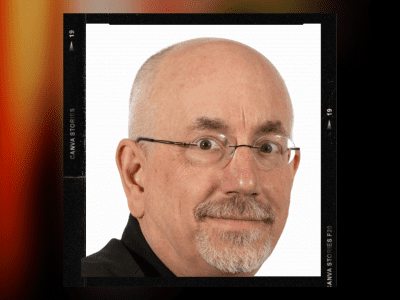Corporate Culture Killers
w/ Kim Crowder
Use the buttons above to listen now.
Transcript - Corporate Culture Killers
Rich: On this episode of Team Building saves the world.
Kim: They have a personality, right? They do. Now, whether they’re able to articulate that and understand the impact of that is debatable. Right? Because remember I told you employees will tell you their stories.
Rich: Yeah.
Kim: Maybe not to your face, but somewhere they’re talking about it.
Rich: Sure. How did this background of yours lead you to singing with Beyonce?
Kim: Oh, you’re so funny, rich. Um, do you understand? Like, then you would’ve made
Rich: Yeah, I, I was, I was like, ok, thank you. I’m out the door.
Hello team. It’s me, your old friend, rich Rininsland host of team building saves the world. The show where I speak to thought leaders from around the world discussing variable strategies and tools to help you and your team build a better work environment. And today we’re hunting down company culture Killers with Communication consultant and the CEO of Kim Crowder Consulting Kim Crowder.
But first, I need to share some love with the rest of my supporters at team bonding. If your team is ready to experience teamwork for the power of play, to visit team bonding.com to learn more. Now, team, please join me in welcoming my guest, one of Forbes top seven anti-racist educators. Kim Crowder. Hello, Kim.
Kim: Hi. Thanks for having me.
Rich: Thank you.
That’s just a small amount of people I keep chained up under my desk. They’re here Just to applaud you. That was their entire job. Thank you for coming on and talking to us today. Kim. Uh, first thing, let’s get right off the bat. Tell my team out there a little bit about, uh, more about yourself, how you got started in this industry and what it is you do.
Kim: Sure. So, uh, my background is in marketing and communications. I, I’m one of those people who worked for the most part in the, the industry that her major was in college, so like lot Oh wow. Of people don’t get to like work, they get a major and then they don’t get to work in unless you’re like a physician or something.
So, uh, but I started off, uh, first internship turned into a job, not first, and internship turned into a job working in, uh, sports entertainment. In Houston, Texas, which is where I’m originally from, and moved into all sectors. I mean, I’ve been in healthcare, I’ve worked for Fortune 500 in retail. I’ve also worked in the nonprofit land and in.
Uh, government work and where I really st and I’ve worked, I’ve moved my way all the way up to the C-suite. So I’ve been in an executive and I’ve been in a director. All of this is important, right, to this conversation when we talk about team building and culture, workplace culture. Uh, so that is my background specifically where I started really looking at what leadership, well, you know, I think I always was thinking about leadership and what that meant.
Mm-hmm. Um, I had the privilege of my first leader coming out of college was. I just had some really amazing people who were willing to help me along the way. But I did work for a black woman, which I think is different because when we look at the numbers around who is an executive in corporate America who are directors, black women, right?
Don’t necessarily fall at the top of that chain. It’s white men, typically white women, right? Men of color than women of color. And so I had the privilege of working for a black woman straight out of college, which was really powerful for me because I saw that it existed. Right, like this exists and I could become Nina Jackson if I so desired.
Fast forward later, I worked for another black woman. I also worked for an LGBTQIA plus man, so I had the benefit of really seeing how leaders of historically ignored backgrounds change their leadership. Based on their own experiences. The way that their leadership is shaped by their experiences, whether we know that or not.
Right. And so I moved into the work that I currently do, especially at that leadership level, after being a part of the C-suite, because that’s when you get a sense of, you know, how decisions are really made, uh, what the, the conversation is around those, you know, around that leadership. And what absolutely destroys a workplace culture.
And I just wanna give people an insight that it’s because my background is in marketing and pr, I’m always thinking how does the internal directly connect with the external, right? Our external audiences, people don’t usually see that through line. Your internal work environment directly impacts the way that you’re able to connect with customers the way that you’re, um, able to build products and that innovation.
So that is where I got my. Quote unquote, start. I’ve done, I have a, I’m currently being Six Sigma, um, green Belt certified. I’m six Sigma leadership certified, so I can’t stop learning. It’s just not who I’m highly curious, uh, which I think is a great benefit to a leader. I’m also, Always working on being more self-aware.
And so that is how I, I, I started, I started pushing, uh, in that C-suite back around some things that I saw happening. Some really, um, inequitable policies. Policies that were not supporting, um, our internal clients, but also some things that we were doing that were not. Be not, not actively looking at our external audiences as fully human.
Um, because usually that mirrors, right, that internal culture will mirror the way that we work with our customers externally. And so that being said, here I am Kim Crowders Consulting, I have an amazing team. It’s not just me, right? Because I need people more brilliant than me. Um, you know, people who are, um, willing to raise their hand and say, actually Kim, I think we should think about this.
I actually. Look for that in team members. Team members that are willing to sort of push back a little bit. I know many people don’t do that. I look for that because I want people to have boundaries when they work. Yeah. With my team. That is actually important to me. I value that. And so what we do as a team, I
is we focus on organizations understanding their internal, external partners, whether that be their team members, whether that be their, uh, their board members, right? So what are those internal conversations and also what are those external conversations with those customers? So we do it in two ways. One, we do it on the Marketing Comm side, where we look at.
What does inclusion look like on that end? And then we also do it from a leadership perspective, supporting leaders and understanding their own leadership identities. How do, how do leadership teams become built around, what their values are around, um, who they are? Right? And whether we say it or not, every leadership team has an identity, right?
They do. They have a personality, right? They do. Now whether they’re able to articulate that and understand the impact of that, Is debatable, right? You know how they land. And so what we do is help leadership teams frame that and also create that in a way that is human centered, so that they are supporting their team members across the board and creating an environment that says no to others who would say, you know, Who would oppose that basically.
Rich: And in all of this, how did this background of yours lead you to singing with Beyonce?
Kim: Oh, you’re so funny, rich. Um, I should have known you were gonna throw that at me. So I’m, I mentioned I’m, well, I don’t know if I mentioned that. I’m originally from Houston, Texas.
Rich: Yeah.
Kim: Um, What I consider one of the best cities on earth.
I know people would debate me, fight me on that one, but, um, Houston is so rich in culture and diversity. Houston, it just has its own personality. I dunno if you’ve ever been to Houston.
I have had that pleasure. Yes.
Yes, it is very much so. It’s own place, like it is everything in Houston. Um, growing up in Houston, Texas, I also am a singer.
And so, you know, rich, I don’t know if I’ve ever told the actual story of how I met Beyonce as a child and then that turned into Kelly Rowland and the other original members I was singing in talent shows at, oh, I think it was maybe 10 or 11. 10 or 11, and my sister and a friend of ours from the neighborhood.
We’re my background singers. Yeah. And we were singing, so this will put me at a age, right? Hold on. By in Vogue. Um, we were singing and I’m, I’m like 11 years old singing that, sing that song. As a contestant. And then Beyonce sang it as a featured guest. Wow. She sang these other things other, she sang it by herself.
She’s this powerhouse little girl. And, um, I remember her dance teacher came up to me and my family mm-hmm. And was like, we need more singers in the group. Which you all joined. And she walked me to backstage and Beyonce happened to be back there with the other girls, and they were so sweet. Oh my gosh.
You did so well. And Beyonce herself said, oh, you were amazing. Fast forward to joining that group. And, uh, somebody asking me just to sing out of the blue, I was so courageous as a child, like somebody would ask me. You know what I’m saying? You just, they’re so different. Yep. And so I, um, I sang just right there, and Beyonce was, Right there.
And she said, do you wanna be in my group? She was the sweetest little girl, quiet, nice, extremely kind. And she said, do you wanna be in my group? And from that point on, um, I would show up at our house for long nights of singing and we stayed in touch. And then now I don’t know, you know Beyonce’s Beyonce is Sure.
Yeah.
Rich: Now it’s Queen B.
Kim: Yeah. Yeah. No, I don’t know Queen B, but I did know B Sweet Beyonce Knowles And Solan as well. Um, Tina. And Matthew as, as children and had been in their house for quite a bit. So that’s, that’s the story. Fantastic.
Rich: Thank you for sharing that. That’s mm-hmm. That was one of those, just doing a little bit of research in the background went, wait, I have to remember to ask this.
Kim: Yeah. People tend to ask that.
Rich: So, all right, so we’re talking about corporate culture killers. Yeah. What kind of things are we looking for? Are, are we looking at, when we do even even mention that title? Mm-hmm.
Kim: You know, rich, you and I know that that’s a, it is a rich topic, right? Yeah. There’s no pun intended.
Um, that is a, it’s a rich topic. Yep. And the reason why is because the way that it shows up in different workplaces can be placed in the same buckets, but it can um, it can show up in different ways, right? Mm-hmm. So you can put it in, in buckets of like, what we don’t use, we don’t use the language abuse in workplaces a lot, okay?
We say toxic work cultures, but actually if you took that behavior and you put it up against something in personal relationships, right? You feel like if you just want me to work all the time, Yeah. You be like, oh my gosh, they’re abusing you, right? Yeah. Yeah. Or if you can’t speak up in the relationship, oh my gosh, you’re being, that’s abusive.
That’s so we use this language externally around personal relationships that we won’t use when we talk about workplace experiences. So you talk about culture killers. Yeah. One of the ways that we see culture is, you know, right now a lot of people are talking about it burnout. Yes, and also P T S D, the trauma that comes, we don’t talk about that enough.
The trauma that comes from being in a work environment, even if it’s not that work environment, but the environment before. Right? Or some at some point in your career. Right. That really damages how you show up in, you know, proceeding workplaces. Right? It kind of takes like a, it takes a toll on you. And also ways that we are seeing this is around outcomes.
And so an example of outcomes would be retention and turnover rates. Mm-hmm. But also who. Is being retained and who’s being turned over the most, at what point in their career, right? When you’re looking at that employee life cycle, what happens to different groups? So disaggregating that data instead of looking at it as a whole is extremely beneficial.
When are women leaving on a regular basis? When are women of color leaving? What has the promotional rates, what, you know, promotion rates looked like in an organization and being really critical about. For instance, let’s say you have a, somebody actually gave me this example, which I thought was really smart.
Dr. Jonathan Ash Long, who is a Brit, um, and a, and a great colleague of mine. But he talked about looking at some data mm-hmm. For workplace that he was working with and he said, People you know, in the organization were like, wait, wait, wait. This black man in this department makes more money than everybody else in the department.
And he said, interesting. Let’s look at this. What he found was that that black man had been there longer than anybody, anybody else, but he hadn’t moved up. And so we don’t look at data like that. Right, right. That really critical approach to data as a researcher instead of sort of taking it at face value.
And so that’s the challenge of workplace data. If you’re presenting that data in a way that hasn’t been really critical of the data, then we may miss the story. And so that’s one of the ways, is not understanding data as a major, uh, workplace killer and then understanding, um, uh, That your team members may have already been telling you what’s going on in the workplace, but you just haven’t been listening, right?
And so team members can sort of drop hints because team members are often afraid to lose their jobs, right? They could be to speak up, but you started to see hints of that and maybe ignored it. So, Those are ways that I, I truly believe that outcomes can really help tell the story if more workplaces were willing to sit with those outcomes and be self-reflective and do something about it.
Rich: What kind of examples have you seen? I mean, when you have a company that comes to you, why do they even come to you in the first place? Do they notice that something has happened and they’re looking to you to help them fix it? Or is it just let’s do our due diligence and make sure we’re covered?
Kim: Plenty of reasons that companies come to us plenty, right?
Mm-hmm. Some of those are, we think we wanna do the right thing, okay? But we didn’t know what was gonna mean all of this, right? So we get in there and start looking at the data. I can give you an example. We found that one company, um, Was losing because of a lack of retention 9 million a year. Ooh, that’s rough.
Cause employees were leaving. Yeah. And, but when we looked at that data, what we found is 101% of their black employees were cycling out every year. Hmm. Over 70% of their latine employees were cycling out every year. Over 50% of their, you, of their Asian, um, employees were cycling out every year. And so it, it.
It what we found in that workplace. Also, when we looked online, because remember I told you employees will tell you their stories. Yeah. Maybe not to your face, but somewhere they’re talking about it. Sure. And so we look at their online footprint, indeed.com. mustard.com. You know, you start to look at where people are providing feedback, burnout.
Burnout, burnout. And then the exit interviews, we started doing exit interviews. Then you find out more information or focus groups where team members privately message you. So all of these are ways that you gather that information. And what we found was that they, they came to us because they you know, one person in the organization felt really strongly in, in the, in the HR role, C H R O C H R O role.
Okay? We felt really strongly about this, but when we turned the data around to the C-suite, they weren’t as invested. And so that’s where those breakdowns can happen, about what moves forward. We mentioned to the, to the CEO what was happening. You know, you all are losing $9 million. One of the things we’re hearing is burnout.
Mothers who are pregnant or you know, pregnant women are saying we, it can’t work in those environments. And the response was, what if that is our workplace? What if that’s our business structure? Right. And so first of all, in any other world, That would be poor decision making, right? If you are costing your organization $9 million, it’s poor decision.
Like there’s no other question around that. The challenges around this in particular, we’re not holding leadership accountable enough to workplace culture. That’s one. So, you know, you go, at some point, you all are likely headed to a PR crisis, but every company thinks they can’t get there. Right. We can’t.
There’s no way that’ll happen to us. Yeah. And then target. And then dove and then, you know,
Rich: it’s, it’s like, it’s like you said before, put it in a relationship context. Mm-hmm. If you can’t keep a relationship, especially with specific types of, of partners, then they’re not the problem.
Kim: Right. Isn’t that right?
Like so at what point do we go to therapy and be honest about that? Exactly.
Rich: Right. Right. But it’s until you go to therapy, you don’t even know. Right?
Kim: Right. So there’s that, but also there are, I just wanna highlight, because I think this is deeply important. There are organizations that come to us who are there and ready to go.
Who are open to the dialogue, who are open to conversation. Here’s what we see in those, the characteristics of those organizations. One, we see really flexible work environments. Super flexible where the leadership has an open dialogue conversation with team members, where team members know that they can raise their hand when there’s an issue.
Mm-hmm. But also where there’s flexibility to make changes that team members can usher in change that that change doesn’t have to come from the leadership level. Extremely powerful. And what we see then, Is, and this is more on the marketing side, what we have seen is something maybe may happen or show up in, uh, something in the pub, a publication of an ad or something.
Right. And when it, before it hits like. The world. Mm-hmm. A team member will say, wait, wait, wait. Remember when we had that facilitation with Kim and here’s some of the things that came up. This could be an issue. And you mitigate, mitigate risk immediately because one of the things we’re passionate about is.
Teaching team members and, and leaders critical thinking. Our goal is not for, for us to be the, the crutch for you. Right, right. Our goal is that you have that critical thinking in the moment that can shift and not only did it impact them as a department, they are able to impact the rest of the organization.
So other departments that they work with, they’re raising their hand and educating them on a regular basis. Mm-hmm. So that’s when we see. This really be powerful. Those are the differences between a workplace that can be ex, you know, impactful around this and a workplace that that could not, and could be placing their organization and their teams in a line of fire, or could be expanding their reach and their impact for years to come.
Rich: Fantastic. Kim, I wanna keep talking about this, but real quick, I hope you don’t mind. I do need to step away for a second. And I want to tell my team out there about a company I’m very proud to be a part of team bonding. Team Bonding was founded over 20 years ago with one simple question. How can employees have a great time while fostering strong authentic bonds between people who work together?
No matter where your company is located? Team Bonding offers powerful, engaging, custom team building events designed to get the best out of your team anywhere in the world. They’ve created a catalog of innovative events using the power of play as a learning tool, and tapping into the correlation of work and play.
From scavenger hunts to jeopardy and so much more. The team bonding of activities, be it live, virtual or hybrid, maximizes the impact of team building with an accent on fun. So visit team bonding.com to schedule your event now. Team bonding. When you want seriously, fun results. And we’re back with Kim Crowder talking about the killing the corporate culture and how we can fight against that.
Kim, in the New York Times, you are quoted as saying diversity, equity, inclusion and anti-racism should be embedded into the DNA n a of organizations in a fully realized way. What does fully realized look like?
Kim: Yeah, two things. So one, I think that article was from maybe three or four years ago. Okay. Right.
Um, and since.
Rich: Was it pre pandemic or, or during the pandemic?
Kim: Mm-hmm. It was post. Okay. During pandemic. Okay. Well, when the pandemic starting then? Yep. Uh uh. And the reason I mentioned that is because I wonder if I would word that differently today. That’s why I mentioned that. So when we talk about in a fully re realized way, I actually would say that this must be a function of leadership.
Rich: Okay.
Kim: And so, and the reason I specifically mentioned that is because there can be an expectation where, which is one of the things why we, our organization specifically focuses on leaders who wanna be human centered, right? Where organizations expect their team members to carry this out without any accountability.
Meaning what? And so be nice to people. Mm-hmm. Um, you know, be an ally, but it’s not coming from that leadership team who can actively one impact the overall way that a workplace operates. Right. Like that workplace culture. So, you know, one of the things I mentioned prior when I said I had that leader who said, This is a business function.
Overworking people, burning people out is a business, right. Is a, you know, this, our business is
Rich: our methodology and it’s worked for mm-hmm. However long we’ve been in business.
Kim: Right. Yeah. But on the flip side, you have a, another leader that I just mentioned who’s flexible, who listens to their team members, who has a feedback chamber back and forth.
Right? Right. And so the reason why I’m, and who is holding themselves accountable as part of this process, right. Of growth. Yeah. And so that is what I mean when I say this is a leadership function, because who can then deny doing the work if the leader says that this is what we’re doing. Hmm. Right. Yeah, because on the flip side then, then you have team members who are pushing up against this, you know, big giant machine.
Whether or not, you know, who may or may not be able to move anything forward. And so that is why I say embed, you know, it has to really be a leadership function when we talk about embedding it into every piece of the work that we do. One, accountability is a huge part of what that looks like. How are, you know, what is the, what are the standards for this as a team, and have you identified that?
Mm-hmm. You know, what we find is that a lot of organizations. They know what their workplace, workplace culture is, but it has not been articulated for their team members. Okay. Which, how many jobs will you, would you have not taken or taken if someone would’ve sat down and said, here are the three ways that we describe our workplace culture.
We overwork you. We are. Do you understand? Like, then you wanna make me
Rich: Yeah. I, I was, I was like, ok, thank you. I’m out the door.
Kim: I, I heard the door. And so one of the things that we find most powerful are organizations who are able to not only articulate that, but articulate, you know, show it in action pretty early in the employment.
In the employment journey. So as you are onboarding, who can actively tell those stories? How are we teaching leaders and other team members to tell those stories about ways we advocate for everyone in the workplace? So when I say it’s in the d n a, people know how to communicate it, but it’s also part of policies.
We’ve actually worked to change policies around X. We’ve worked with an organ, we, we, we spoke with an organization, not worked with, I have a podcast myself where I talk to someone. Who was trans, who transitioned in a, in their current workplace. Okay. Um, uh, as lgbtq I plus they transitioned and they were able, they had a leader in their department who went up to the, uh, C-suite as far as HR is concerned.
Yeah. Which then led to executives about gender affirming care. What then do we have in place a change policy to support that person?
Rich: That’s fabulous.
Kim: That that person is now a leader and because of their experiences, they have shaped, that’s shaped the way that they lead. Mm. Cause of the way. Do you understand what I’m saying?
Rich: Yeah, yeah, yeah.
Kim: This is a ripple effect. This is huge. And so that is, when I talk about ways that it can be embedded, That is what that looks like. It is always in action. It is always connected to accountability.
Rich: In your experiences, the companies that are having problems, getting that started, getting it off the ground, is it, I don’t want you to go into specific company names Sure.
By any, by any way, shape or form.
Kim: Never. I like my job,
Rich: but, um, is it a specific type of industry or a specific type of organization that have these problems?
Kim: No, I wouldn’t say that that is the case. It really is tied to what leaders are willing to do and not do. Hmm, I’m really rich. It is that you can walk into any organization who has decided that as a leadership team, this is what is important.
We only bring forth leaders who focus on this. We actively, you know, like we look for leaders. With these qualities so that then the workplace environment is this. There’s no other way around that. And we’ve seen this in industries from tech. We’ve seen it in. Education. Mm. We’ve seen it in major retailers like Fortune 500 companies who have gotten this right and who are not complacent with where they are.
So there’s, they’re always looking for ways to, you know, to expand around building a stronger workplace culture. Where they are is never good enough. Uh, when it comes to making sure that people are humanized in the workplace.
Rich: Let’s say that I’m management and I ha and I see someone in mid-management or lower, but I think they’re earmarked for the C-suite.
I think they have their, they’re meeting their goals. You know, the bottom line that the company is always looking for. They’re the ones who are making these things happen, but when it comes to leadership, they’re getting in their own way. Their, their ego is, is keeping them from really integrating with the team.
How can I, uh, start to assist them in changing that outlook
Kim: if you’re a mid-level manager? Yeah. Yeah, that’s a good question. One way that we’ve seen that happen is with, um, employee resource groups. Okay. Or in finding someone in the C-suite who is also just as passionate, even if it’s one or two.
Rich: Okay.
Kim: Who then take that information back.
Rich: Okay.
Kim: You know, there’s always a challenge. You know, the truth of the matter is, is most of us just wanna go to work so we can eat sure and live, right? Sure. Yeah. I mean, many of us are not like deep down in the dirt, passionate about the work that we do. We find some people who are able to do that, right?
But for the most part, most people are like, I’m working because I have to feed people and I have to feed myself. And I have, do you know if we’re just really honest? And so in that, Understand that the, the risk for some folks is very different than others. Mm-hmm. Everyone doesn’t wanna be at that level of leading the charge around this.
Right. But for those folks that do, and you have seen that in other leaders, is there a way you can connect with them Okay. And get them on board so that they can bring that forward. Also, it is important to recognize. Your own identity as part of this conversation. And what do I mean by that Is, is that some folks have access to having those conversations, right, without being penalized in ways that others do.
Okay, so. You know, you find women of color, people of color, um, versus a white man bringing that forward. Mm-hmm. And even with a white man, is he LGBTQI plus? What kind of personality does he have? Is he more boisterous? Right. All of this is a part of the conversation, and so if you have privilege, the benefit is that you can bring that forward and people may be willing to listen to you, especially if your background is.
Of that dominant culture. Mm-hmm. But here’s what that doesn’t mean. It does not mean that those folks who are not from that culture don’t have power. We’ve seen this happen at Amazon. You think about Amazon and creating the union in New Jersey mm-hmm. Where those team members galvanized, right? Yeah. And we’re able to, you know, you either move, like you have to move, you cannot.
Um, not pay attention to us anymore. And so then that’s when collective becomes really important. Yeah. When we start talking about those team members, uh, who maybe are not at that C-suite level, who are not even at that senior level, who can galvanize as a team and bring that forward. We’ve seen many team members sign.
Um, you know, like sign a, a petition for a workplace, right? We all agree that this should be happening. That can also happen in a workplace as well. And so just considering where you sit at a workplace, what your identity is, and the power dynamics is really important to decide how you’re gonna move something forward.
Rich: Can you gimme some examples like, uh, that you’ve seen like that where the individual themselves, where the employee, the lowest rung. If you will, of the employee scale actually was able to, to make that change happen for not only themselves, but for the company in general.
Kim: Yeah. We, I, I, I mentioned one Amazon, right?
Is a great example, right? The unionizing of those team members, uh, and we have labor rights. Labor rights movement have been a thing forever, right? Like we can, you know, you go through history. I am a man with the, the railroad. Like you can go. Throughout history and sea labor rights movement, not only and at workplaces, but expanding into societal culture, right, in ways that we have to work.
Uh, when I talk about an example specifically for organizations that we’ve worked with, I think the, you know, I, I mentioned an example. Prior where, and maybe where we have had team members who say, particularly in the hr, say, right, this is really important, and my C-suite is not a hundred percent on board.
They’re kind of there. Yeah. But we wanna bring you in as a facilitator to help our, our leadership understand more of why this is important and what their role in this is. And so it is, it maybe it doesn’t land fully in that day. But it is an extension of a baseline around where their leaders can go. And then we may hear from them six months later where their leaders are going, oh.
Now I get it. Now I understand why this is so important. A good example of this is somebody, she was a, a black woman who was a chief human resources officer. Mm-hmm. Who, um, asked us to come in and, and work facilitate with her leaders. We had, and I will say in that, um, space, the c e o was completely on board.
Uh, several were completely on board. It was really a beautiful experience. Which she mentioned later on, she said there was one particular person in the C-suite and we could not work together. Like we could not, we just couldn’t work together for whatever reason. It was always a rub. After he went through your facilitation, totally different person.
We later on did some facilitation around something else, and this same person, he showed up excited, he was answering questions. He was, he had retained information and he was ready to go. Right. And so these are different ways, right? You know, like there’s, sometimes it’s a science cuz you can, we can take a look at the actual, uh, numbers after working with them over time.
And then sometimes we also take that qualitative information because it is important. And because of that, they had a great working relationship and it changed the way that she was able to support him and his team as well.
Rich: What about generationally is Yeah. Yeah. Because we still have five generations and growing mm-hmm.
In a, in a workplace environment. I mean, how likely is it that you’re gonna be able to get the greatest generation to help with this with, with, with maintaining corporate culture?
Kim: Yeah, this is, that’s a great question. I, I, one, I think the best thing for us to do is not assume that because someone is from a particular generation, that they are not on board for change.
Right. I think that that is powerful. I remember my grandmother, I. Who was a preacher’s wife who was very much so in favor of LGBTQIA plus.
Rich: Nice.
Kim: Right, right. Yeah. And, and, and didn’t come to that, or really, we didn’t talk about it until she was in her later years. Mm-hmm. And so the assumption that that expansion cannot happen even at any, at an older age is just, I don’t, I don’t buy that.
Right. What we find is that, We often ignore how age impacts the ways that the workplace treats us. The workplace environment treats us. Okay? And so one of the things that we hear, particularly of those folks who are of an older age, Who are over 45, 50 years old. Mm-hmm. And present as such. You know, some people present younger and people don’t know, but those folks that present, present as such, Particularly women, because I think that’s an important part of the conversation, right.
Particularly women. I think men are allowed to get older in the workplace in some ways. Yeah. Um, especially at the C-suite level. Right. As opposed to women. Uh, and so in those conversations, what we find is that in those inter intergenerational teams, that they themselves feel like people think they’ve aged out.
Mm-hmm. And then also for the younger generation, right? There’s this separation and I think what one of the things that organizations can really do to fuse that gap mm-hmm. Is to talk about it. How many organizations never bring up intergenerational workplaces as a conversation. Yeah. Like never talk about it.
Right? They, they, they just assume when they build teams, everything’s gonna be fine. It’s gonna harmonious because people are coming in based on skillsets. And we know that skillset is not enough to make a harm harmonious team. Right? And so the more that organizations are willing to talk about, here are the ways we expect.
Teams to be created so that everyone is seen and heard the better. How do we, Ben, what are the benefits of having someone who’s had a longer, uh, time in the workforce who had some maturity at that level, but also how do we celebrate innovation? Right? And newness of ideas around and, and, and do. Are we open to pushback on the question of, can you tell me more about why we do it this way?
Instead of, this is just how we’ve always done it, right, that, that leans into that flexibility and inflexibility.
Rich: Kim, clearly we could continue talking about this till, you know, we’re, we’re both old and gray like me, but, uh, I just, I wanna thank you for coming on and sharing your insights and your knowledge about this.
Um, please team out there, give a big round of applause. To Kim Crowder. Kim, is there anywhere that people can go to find you if they wanna find out more information about this? Like your podcast, for example, or, or just, uh, in general. I.
Kim: Yeah, the podcast is releasing Soon we’ll be releasing it in the next few months.
It is called the Anti Asshole Leadership Podcast.
And so,
Rich: dammit, I wanted that title.
Kim: Oh, right. It’s a play on words, but it, it’s, we wanted to keep the podcast, you know, so much about when we talk about workplace cultures like. Boring and heavy, and we wanted to keep it fresh fun, but also really truthful, like, and I think that that title says all of that.
Sure. On the flip side, if you are, if you want to know when that podcast drops, if you want to know more information about Kim Credit Consulting, you can go to kim credit consulting.com, sign up for the newsletter. And follow me on LinkedIn, Kim Crowder on LinkedIn. I think I’m at 65 K followers. It, we have a great time there as well.
Rich: Fantastic. And I look forward to, to listening to your podcast and, uh, maybe we can give each other a little back and forth as when it comes out. We’ll promote you if you promote us kind of thing.
Kim: That sounds good. Thanks Bri. Thank you
Rich: Kim. And, and I hope you’ve enjoyed yourself being here today. It’s been a pleasure.
Thank you. I hope that continues to be so because. It’s time for my speed round.
Speed round. So I explained this to Kim just a little bit before we began, which is to say the speed round is basically Kim, just 60 seconds, where I’m gonna ask you a series of questions that really don’t mean much of anything. It’s just a way of us getting to know you. They’re completely innocuous questions, but the objective is try to get as many as you can within 60 seconds.
So I count the questions asked in case anybody out there is wondering. I always count how many of very many questions were asked before the time runs out, and if you’re feeling at all competitive. We’ve reached 14 so far this season. Good. God, don’t feel like you have to hit it, but if you can, fantastic.
All right. So do you think you’re ready?
Kim: I’m ready.
Rich: Let’s have some fun. Soon as you hear the music, I’ll start asking questions and away we go. What’s your name?
Kim: Kim.
Rich: How many kids do you have?
Kim: Zero.
Rich: How many pets?
Kim: Zero. Unless you count my plant.
Rich: Okay. What’s the most beautiful place you’ve ever been?
Kim: Oh, Ghana.
Ghana. Uh, acro. Acro, darn
Rich: nice. Name a celebrity that you admire the most.
Incorrect.
What accomplishment are you most?
Kim: Proud of being a great family member to my nieces, being an aunt, being my great sister.
Rich: Fantastic. What do you think is the best age to get married?
Kim: Whenever you damn well, please.
Rich: What would you do if you were invisible for a day?
Kim: Oh, I would, oh gosh, what would I do? I would probably, I would travel on purpose so I could like overhear what people were saying and Nice. Involved in culture.
Rich: What do you remember most from kindergarten?
Kim: Oh, I think I remember my. Oh gosh. Where was I in kindergarten? I lived in Korea at that time. Woo.
Really? And so, yeah, I remember being in Korea as a kid at that time.
Rich: Lovely. You got nine. Nine Kim, but nine really thoughtful answers. I love that. Well done. Kim, once again, thank you so much for coming on board and thank you, my team out there. That’s it. We’re wrapping up yet another episode of Team Building Saves the World.
If you’ve enjoyed this show with you’re an old fan of the pod of the podcast or brand new to it, please be sure to share it with everyone you know, whether they’re, you know, a family member or coworker, what have you. It helps us to share all the vital information that we discussed. During this podcast, you can find out all about us, including all past episodes@teambondings.com slash podcast.
You can also find us wherever you find your favorite podcast, Google Podcast, apple Podcast, Spotify. We’re wherever you listen, and please go and find us on The Social Media is a Team Bond podcast. Leave me a message, tell me what you liked about the show. Tell me what you didn’t like about the show. I want to hear from you, even if you have an idea for future topic.
This is how you become a vital member of our team. Speaking with my friends before we. Say our final farewells for this episode of Team Building saves the world. Please never forget that if you’re within the sound of my voice, you’re on my team now, and I am forever going to be on yours. I’ll see you next time.
It’s been said
that you learn more about a person in an hour of play than in a year of conversation, so why not put your coworkers to play with the help of the team at Team Bonding? Team Bonding was founded over 20 years ago with one simple question, how can employees have a great time while fostering strong authentic bonds between people who work together?
Their catalog of innovative events includes scavenger hunts, jeopardy, and much more. Each activity, whether live virtual or hybrid. Maximizes the impact of team building with an accent on fun. Visit team bonding.com to schedule your event now. Team bonding when you want.
Seriously, fun results.
June 6, 2023
On this episode of Team Building Saves the World, Rich speaks with Kim Crowder and discusses the destructive elements that can hinder a healthy corporate culture. She highlights toxic leadership and its negative impact on employee engagement and retention. Listen as Kim shares practical strategies to combat these culture killers and emphasizes the importance of fostering a positive and inclusive work environment for overall business success.
About Kim Crowder:
 Kim Crowder, Founder & CEO of Kim Crowder Consulting, is one of the country’s executive, leadership and diversity, inclusion, and equity speakers, coaches, trainers, and consultants.
Kim Crowder, Founder & CEO of Kim Crowder Consulting, is one of the country’s executive, leadership and diversity, inclusion, and equity speakers, coaches, trainers, and consultants.
Kim and her team work across industries serving global organizations. From leaders and executives at Adobe to Smugmug, the American Library Association, HarperCollins Publishers, and more, Kim and her team provide executives and leaders with actionable tools to build healthy, people-centered workplaces long term.
Kim has been named by Forbes as a “Top Anti-Racism Educators Companies Need Now,” A Top 10 Diversity, Equity, and Inclusion Expert by All American, and Top Influential African-American Business Women To Follow by LinkedIn. She is also a member of the MIT Technology Review Global Panel and For(bes) The Culture, and is a LinkedIn Top Voice.
She has been featured by The New York Times, Business Insider, Cheddar News, CBS, NBC, FOX, Katie Couric Media, regularly by Forbes, on Hubspot’s podcast, The Growth Show, Workology, and As Told By Nomads.
Visit our blog to learn more about corporate culture killers and how to address them with your team.
" I think the best thing for us to do is not assume that because someone is from a particular generation, that they are not on board for change. I think that that is powerful."- Kim Crowder
Get more human resources and leadership advice.
Less drama? Greater teamwork and job satisfaction? TeamBonding is here to help you build a stronger and happier team. Subscribe to get our team building podcast and thought leadership blogs sent straight to your inbox.















